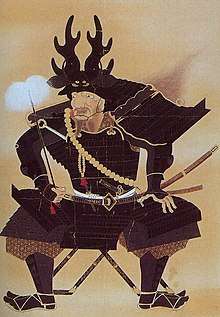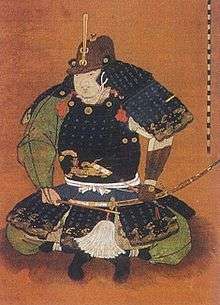Shitennō (Tokugawa clan)
The Four Heavenly Kings of the Tokugawa (徳川四天王, Tokugawa-shitennō) is a Japanese sobriquet describing four highly effective samurai generals who fought on behalf of Tokugawa Ieyasu in Sengoku period. They were famous during their lifetimes as the four most fiercely loyal vassals of the Tokugawa clan in the early Edo period.[1]
Etymology
The sobriquet evolved from the "Four Heavenly Kings" of Buddhist iconography. These are said to be the guardians of the four horizons.[2]
Fudai leaders
Each of these four generals was the founder of a cadet branch clan:
- Honda Tadakatsu[3] of the Honda clan[4]
- Ii Naomasa[5] of the Ii clan[6]
- Sakakibara Yasumasa[1] of the Sakakibara clan[7]
- Sakai Tadatsugu[1] of the Sakai clan[8]
Tokugawa Four Gallery
 Ii Naomasa
Ii Naomasa
(1561–1602) Honda Tadakatsu
Honda Tadakatsu
(1548–1610) Sakakibara Yasumasa
Sakakibara Yasumasa
(1548–1606) Sakai Tadatsugu
Sakai Tadatsugu
(1527–1596)
gollark: +>markov
gollark: +>markov
gollark: +>markov
gollark: +>markov
gollark: +>markov
See also
- Shitennō (samurai)
- Shitennō-ji
- Kōdōkan Shitennō
Notes
- Nussbaum, Louis Frédéric et al. (2005). "Sakakibara Yasumasa" in Japan Encyclopedia, pp. 811., p. 811, at Google Books; n.b., Louis-Frédéric is pseudonym of Louis-Frédéric Nussbaum, see Deutsche Nationalbibliothek Authority File Archived 24 May 2012 at Archive.today.
- Nussbaum, Louis Frédéric et al. (2005). "Shi-tennō" in Japan Encyclopedia, pp. 875., p. 875, at Google Books; n.b., Louis-Frédéric is pseudonym of Louis-Frédéric Nussbaum, see Deutsche Nationalbibliothek Authority File Archived 24 May 2012 at Archive.today.
- Nussbaum, "Honda Tadakatsu" at p. 347., p. 347, at Google Books
- Appert, Georges. (1888). "Honda" in Ancien Japon, pp. 65., p. 65, at Google Books
- Nussbaum, "Ii Naomasa" at p. 374., p. 374, at Google Books
- Appert, "Ii" at Ancien Japon, p. 67., p. 67, at Google Books
- Appert, "Sakakiwara" at Ancien Japon, p. 77., p. 77, at Google Books
- Appert, "Sakai" at Ancien Japon, p. 76., p. 76, at Google Books
References
- Appert, Georges and H. Kinoshita. (1888). Ancien Japon. Tokyo: Imprimerie Kokubunsha. OCLC 4429674
- Nussbaum, Louis Frédéric and Käthe Roth. (2005). Japan Encyclopedia. Cambridge: Harvard University Press. ISBN 978-0-674-01753-5; OCLC 48943301
Further reading
- Bolitho, Harold. (1974). Treasures Among Men: The Fudai Daimyo in Tokugawa Japan. New Haven: Yale University Press. ISBN 978-0-300-01655-0; OCLC 185685588
This article is issued from Wikipedia. The text is licensed under Creative Commons - Attribution - Sharealike. Additional terms may apply for the media files.